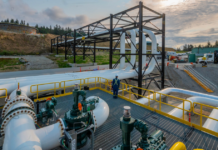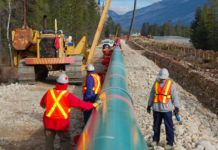The Canadian government announced plans to substantially increase its production of nuclear energy by signing a pledge to triple its nuclear capacity by 2050, along with 22 other countries at COP28.
“This is very significant. Canada is joining 22 countries in signing a pledge to triple its nuclear capacity by 2050,” said Chris Keefer, co-founder of Canadians for Nuclear Energy.
COP28, the United Nations Climate Change Conference is taking place in the United Arab Emirates, which began on Nov. 30 and will continue until Dec. 12.
Canada had previously left nuclear energy out of its 2022 Green Bond program, which is aimed at supporting clean energy projects, however, it’s now planning on using the source as its primary energy source towards reaching its 2050 Net Zero emissions targets.
“This represents, I’ll call it a U-turn, in Canadian policy. We’ve gone in the last two years from a very lukewarm approach to nuclear to a very warm embrace,” said Keefer.
Keefer, who also founded Doctors for Nuclear Energy, said that it’s the reliability of nuclear energy that led to the government’s change in policy, as green, solar and wind sources lack consistency by comparison.
“I work in a hospital. My son was in an incubator for five weeks. I take the stability of our electricity grid very seriously,” Keefer told CTV News.
Keefer has now been a participant in the United Nations Climate Change Conference three times.
Other participants disagreed with the pledge, suggesting instead a combination of battery storage with wind and solar.
Quebec also proposed a hydroelectric production option which is highly beneficial for Ontario and other parts of Canada, when compared to nuclear reactors that currently only supply about 15% of the electricity Canada requires.
In August however, Hydro-Quebec said it was considering reopening the Gentilly-2 nuclear power plant in Becancour as a possible avenue to meet the province’s electricity demand.
“It doesn’t make any sense to build more nuclear reactors when there are much cleaner, safer, and lower cost options to keep our lights on,” said Jack Gibbons of Ontario’s Clean Air Alliance.
Ontario will be at the forefront of tripling Canada’s nuclear production should the pledge come to fruition, already being home to 18 of Canada’s 19 operating nuclear reactors. The province also has plans to build more.
“We are looking towards an announcement, I think later this month, that the government will proceed with refurbishing most of the reactors at Pickering. There is 4800 megawatts of new nuclear capacity being planned at Bruce Power. We’ve got the Small Modular Reactors going in at Darlington, but there is a role right across the country,” said Keefer.





















